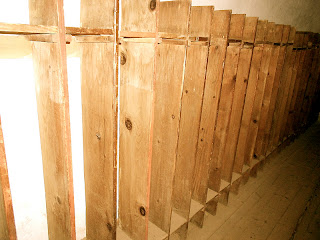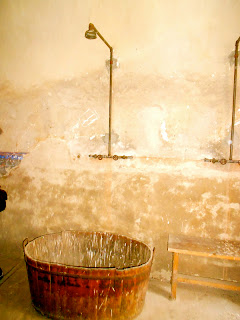I will warn you, this post is not for the faint of heart. The first part of this post contains many gruesome photos and facts about Terizin, a concentration camp in WWII. Please do not feel pressure to read if you are not comfortable with this.
It incredibly difficult to hear about and see these sort of things, but I think it's important to honor those that have passed on from WWII to carry on the legacy so that we may learn from their mistakes. By visiting this place where so many gave their lives against their will makes me feel as though I'm honoring that their lives mattered and that they did not die in vein.
It incredibly difficult to hear about and see these sort of things, but I think it's important to honor those that have passed on from WWII to carry on the legacy so that we may learn from their mistakes. By visiting this place where so many gave their lives against their will makes me feel as though I'm honoring that their lives mattered and that they did not die in vein.
I find the second world war both disgusting and intruiging. No matter how hard we try, we will never understand why so many people let this happen. Never will we think what happened there was tolerable, but by learning as much as we can about, we can help the legacy live on for our children to learn from as well….
Today was a very different day than the others.
We had a very solemn, life changing visit to Terizin, a Nazi concentration camp during WWII.
It was a place where many, many jews were held and burned on the crematorium on site. 35,000 to be exact, and this wasn't even a death camp, it was a holding camp for Jews, mainly on route to Auschwitz. The camp actually had a history before World War II even began as a fortress and military prison. The man who is said to have started World War I, by assassinating the Archduke Franz Ferdinand of Austria, was held at Terizin for 4 years before he died from the horrible conditions in the prison.
I will never understand how so many human beings could be so horrific. It makes me feel so incredibly blessed to have the opportunities and responsibilities that I do. It's important for us to remember just how good we have it, and live each day just as if it was our last, because one day, it will be.
We had a very solemn, life changing visit to Terizin, a Nazi concentration camp during WWII.
It was a place where many, many jews were held and burned on the crematorium on site. 35,000 to be exact, and this wasn't even a death camp, it was a holding camp for Jews, mainly on route to Auschwitz. The camp actually had a history before World War II even began as a fortress and military prison. The man who is said to have started World War I, by assassinating the Archduke Franz Ferdinand of Austria, was held at Terizin for 4 years before he died from the horrible conditions in the prison.
Jewish cemetery on the grounds where thousands are buried.
This sign was on most concentration camps during WWII, labor camps especially. In English, it means, "Work makes you free." It was meant to be sarcasm towards the prisoners since they would thousands would die working for the Nazis. Unbelievable.
I believe this is a warning to the Jews about the dogs that would attack them if they tried to escape.
All cells for the Jews.
Most prisoners here died of starvation, epidemics, hypothermia, torture from the Nazi guards, and myriad of other causes before they even made it to the gas chambers at Auschwitz.
These were "lockers" for the belongings that they never got to keep.
This cell held as many as 74 people at one time.
See the fence above the walls? It was almost impossible to escape because of this, the dogs, and the constant Nazis on guard. Many prisoners were given time in solitary confinement for trying to escape or trying to smuggle in food. Solitary confinement meant a minimum of 4 days without food, water, or a bathroom in a concrete cell with absolutely nothing in it.
Solitary confinement cell.
This is the baths where Jews that were here for 5 months maybe got to bath twice if they were lucky, and this was only if they were spreading disease.
These are the steamers for the disinfection of the clothes after the people arrived at Terizin. They were sent on trains from their homes or other concentration camps. Many times, they were packed like sardines on the train for weeks without a bathroom or any means of hygiene whatsoever. So, when the Jews arrived, they were typically covered in sewage and swarming with insects and disease. So, once they checked in at the reception, there clothes were steamed, and they were given 10 minutes in a cold shower with 500 other prisoners. After the shower, they were forced to put back on their soaking wet clothes and go to work even if it was the dead of winter. Many died from hypothermia as soon as they started working outside.
Since the prisoners were used to the disinfection process once they arrived at the camps, when they were shipped to Auschwitz, they were brought to showers just like these, and waited for the water to come on. Instead of water came the gas.
This "men's shaving room" was used only one day. The Red Cross was suspecting about activity in the camps, so they scheduled a visit to Terizin and Auschwitz to check it out. Terizin was given 14 months notice. They built up schools, stores, banks, parks, etc. around the grounds as a sort of cover. They told the Red Cross it was Jewish Community, or a safe place for the Jews to live until WWII was over. They even made a movie called "The Gift of a Town" depicting the happy people at Terizin running around with their kids, playing tennis, shopping at the stores. The propaganda put forth by the Nazis at Terizin was so convincing, that the Red Cross cancelled their visit to Auschwitz.
Here is some footage of the film.
This is the building that Nazi soldiers lived with their families on the grounds.
A list of camps that the prisoners eventually went on to. Notice number one is Auschwitz. Of the children that came here, only 245 lived on. They were treated better than the adults or the elderly, but not much.
This is one of the execution areas where prisoners were shot or tortured. The other Jews were forced to watch. See the barracks on either side? Imagine people being tortured or killed right outside your window.
Execution area. Notice the blood stains.
These are the "beds" for the Jews. They had no mattresses.
Part of the barracks. Here, they were fed 200grams bread in the morning and a small cup of vegetable soup at night after 18 hours of work. This totaled about 500 calories per day. Most of us need 2,000. This was enough to keep them alive and working, while wasting away.
These are the bathrooms that 600 people were forced to use. There are two of them. It was essentially a hole in the ground, and most times they were filled up, so that sewage flowed right into the barracks. The day that WWII ended Terizin was liberated by the Russian army, the Nazis locked all the Jews into this holding cell with the bathroom in the middle of summer before they fled. 1500 Jews made it through the war, but because of this act of torture, died due to the epidemics spread by the sewage before anyone could let them out.
This cell and the one below held 21 people at one. Yes, they are as small as they look in the pictures.
A swimming pool that the Nazis forced the Jews to build for them. But, of course they were never allowed to use it. The Nazis also forced them to maintain the grounds, build tennis courts, etc.
Dead bodies at Auschwitz
The road to the crematorium.
Cemetery by the crematorium
Crematorium. No pictures were allowed inside. There were four incinerators inside and an autopsy room to the side which still had blood stains on the tables. The remains of 20,000 Jews were thrown in the river next to the camp.
These are the bodies in wheelbarrows being taken to the crematorium
This owl is at the top of the crematorium. While it's usually a symbol of wisdom, in this case, it is a symbol of the suffering and frustration that happened here. It literally means, "Eternal Night."
I will never understand how so many human beings could be so horrific. It makes me feel so incredibly blessed to have the opportunities and responsibilities that I do. It's important for us to remember just how good we have it, and live each day just as if it was our last, because one day, it will be.







































My Mom went and toured a concentration camp in France from this time. She just so happened to be touring it when a concentration camp survivor was revisiting the site. He was kind enough to give them the tour. I think the most shocking part of it was that when he finally got out and told his family where he had been, nobody believed him... I mean who can make this stuff up? It's absolutely horrifying!
ReplyDeleteMorgan